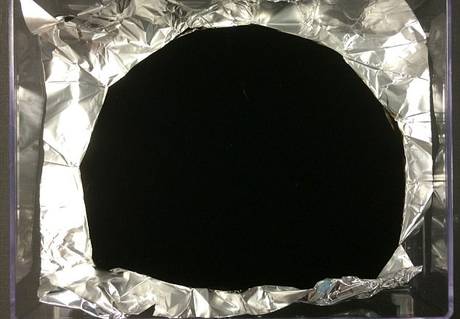You might have thought black is too solemn or boring, but you may just change your mind. Through careful material science manipulation, involving thousands of tightly packed carbon nanotubes, British company Surrey NanoSystems made a super black coating that absorbs almost 99.96% of visual light – a world record. Practically only a tiny fraction of the visual spectrum is reflected, so the only thing our eyes can discern is a bizarre abyss, akin to a black hole.
Dubbed Vantablack, the coating is made up of carbon nanotubes – rolled-up sheets of carbon 10,000 thinner than a strand of human hair – that are so tightly packed together that light can’t pass through. It’s only the ultra-short wavelength light that peers through, but that’s far from being enough to actually make the material look like … anything but void.
The nanotubes were grown on sheets of aluminium, but even if you fold and twist the Vantablack material in any direction any shapes, counters or depth become entirely lost because of the material’s light absorbing capabilities.
“You expect to see the hills and all you can see … it’s like black, like a hole, like there’s nothing there. It just looks so strange,” said Ben Jensen, the firm’s chief technical officer.
The material will be used to calibrate optical instruments like astronomical cameras, telescopes and infrared scanning systems to get better readings. Also, because it’s SO black, the material conducts heat seven and a half times more effectively (remember Planck’s law) than copper and has 10 times the tensile strength of steel (an inherent property of carbon nanotubes).
“It reduces stray-light, improving the ability of sensitive telescopes to see the faintest stars, and allows the use of smaller, lighter sources in space-borne black body calibration systems. Its ultra-low reflectance improves the sensitivity of terrestrial, space and air-borne instrumentation”, said Jensen in a release.
“Many people think black is the absence of light. I totally disagree with that. Unless you are looking at a black hole, nobody has actually seen something which has no light,” professor of colour science and technology Stephen Westland from Leeds University in the UK told The Independent. “These new materials, they are pretty much as black as we can get, almost as close to a black hole as we could imagine.”
The Vantablack coating was described in a paper published in the journal Optics Express.










